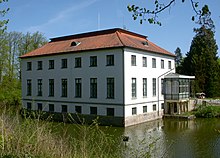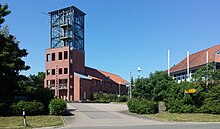Lensahn
| coat of arms | Germany map | |
|---|---|---|

|
Coordinates: 54 ° 13 ' N , 10 ° 53' E |
|
| Basic data | ||
| State : | Schleswig-Holstein | |
| Circle : | Ostholstein | |
| Office : | Lensahn | |
| Height : | 17 m above sea level NHN | |
| Area : | 27.7 km 2 | |
| Residents: | 4938 (Dec. 31, 2019) | |
| Population density : | 178 inhabitants per km 2 | |
| Postal code : | 23738 | |
| Primaries : | 04361, 04363 | |
| License plate : | OH | |
| Community key : | 01 0 55 027 | |
| Office administration address: | Eutiner Strasse 2 23738 Lensahn |
|
| Website : | ||
| Mayor : | Klaus Winter ( CDU ) | |
| Location of the community Lensahn in the Ostholstein district | ||
Lensahn is a municipality in the Ostholstein district in Schleswig-Holstein . The full-time administered municipality carries out the administrative business for the office of the same name to which it also belongs. Brunskrug, Rosenhof, Rugenhandschen, Lensahnerhof, Johanneshof, Speckkaten, Petersdorf, Wahrendorf, Sipsdorf and Schanze are in the municipality.
History of Lensahn
The oldest document that proves Lensahn's existence comes from the year 1222. In it the name "Linsane" is mentioned in a sales contract and "Rotbertus de Linsane" is named as a witness. The place name is of Slavic origin and translated means something like "inhabitant of the undeveloped new land". Attempts to derive the place name from the Low German language could not prevail. The old name "Linsane" should therefore indicate "a field tilled with linseed". In 1245 the construction of the brick-Gothic village church began as the founding of the rulers of the Schauenburg region . A certain Eggert von Heesten became the first owner of Lensahn in 1440. Ten years later, in 1450, Hartwig von Buchwald acquired the Lensahn estate, which in turn was replaced ten years later by Mathias von Ratlau .
Several plague epidemics are mentioned in the church chronicles and the turn to the Lutheran faith is confirmed from 1542, since the Reformation in the Duchies of Lensahn certifies a total of 36 hooves (together with Wendisch-Lensahn and Beschendorf).
The Petersdorf estate is located north of the Lensahn community. Petersdorf emerged in the first half of the 16th century through an inheritance from the Gneningen estate, which no longer exists today . The manor house got its current appearance under Baron Hans Detlef von Hammerstein . Today the estate is a pure arable farm, where, among other things, rapeseed , wheat and winter barley are grown. The entire facility is under monument protection .
Thirty Years' War
The "Petrus" bell was cast in 1622 - it still rings today in the church tower. Imperial troops under Tilly looted and devastated Lensahn in 1628, which in 1633 received a new owner in Detlef Ratlow zu Lensahn . Lensahn was hit again in 1643 by a Swedish occupation.
18th century
Billing during the Great Northern War (1700–1721) did not have any negative consequences for the now small village.
Pastor Hartmann , who was in office in 1760, made Lensahn a paradise for marriage in Holstein and at the same time promoted the introduction of the potato . In 1769 Koselau, Sebent, Lübbersdorf, Kuhof, Kremsdorf, Bollbrügge, Sütel and Sievershagen became the property of the grand ducal family (so-called “younger Fideikommißgüter”). In 1795, Duke Peter Friedrich Ludwig set up work and industrial schools (handicraft lessons for young women) in Lensahn and Beschendorf. In preparation for release from serfdom , practical skills such as spinning, knitting, darning, sewing, etc. were taught.
With the end of serfdom in Lensahn, Pastor Petersen founded an economic reading society in 1798 (i.e. an association for the procurement of specialist agricultural literature). The Hufner became time leaseholders and received lease contracts that precisely regulated all rights and obligations.
19th century
In 1828 the Wagrische Landwirtschaftliche Verein was founded in Lensahn, which then became the Schleswig-Holstein Agricultural General Society in 1834 . In addition, from 1832 to 1848 the construction of the road from Eutin to Lensahn was pushed ahead. In the revolutionary years of 1848/1849 Schleswig-Holstein rose against the Danish government, and a fighting association was formed in Lensahn. But it was not until after the German War in 1867 that the duchies of Schleswig and Holstein were incorporated into the Kingdom of Prussia . The introduction of the general Prussian conscription of three years led to increased emigration to the USA. In 1890 the Lensahn volunteer fire brigade was founded .
20th century
During the Kapp Putsch in March 1920, a command post for the putschists was formed in Lensahn for a few days .
The gymnastics and sports club TSV Lensahn from 1924 e. V. was founded in 1924. Its last annual general meeting took place in 1940.
In 1945, the Lensahn Reichsgetreidehalle and the adjacent beet pulp factory were closed as an armaments factory by GEMA (communications test command in Kiel / Pelzerhaken , GEMA-Werke Berlin). The Mechanische Werkstätten Lensahn (MWL) were founded in June 1945, followed by the Willisen-Apparatebau Gesellschaft (WILAG) as successor companies (including production of radios, from 1946 in buildings on the Grüner Hirsch).
In 1946, TSV Lensahn von 1924 e. V. after the Second World War.
After WILAG went bankrupt in 1949, the Greiling cigarette factory took over the WILAG factory building that was under construction and produced cigarettes at the Grünes Hirsch. Opal began manufacturing tights at the same location, after which Transcodan, now Codan , began manufacturing and selling medical single-use transmission systems at the Grünes Hirsch.
The Blau-Gold Lensahn tennis club was founded in 1949.
On September 1, 1952, took District Fire Brigade Association Ostholstein firefighters Technical Center in operation.
politics
Community representation
The mayor is Rolf Schröder ( FDP ).
mayor
Mayor is Klaus Winter from the CDU .
coat of arms
Blazon : “Divided and half-divided. Above in blue a golden fallow deer antler on the skull bone, below right in red a golden ear of wheat, on the left the two Oldenburg bars red in gold. "
The Lensahn coat of arms was only approved in 1950. While the golden ear indicates the predominantly agricultural character of the municipality in the past, the fallow deer antlers refer to the formerly important fallow deer population in the Lensahn area. Since Lensahn was part of the Gottorfische and later Oldenburg entails for several centuries, the red crossbars in gold were removed from the Oldenburg shield to commemorate this.
economy
- Lensahn is the seat of the German medical supplies company CODAN .
- Lensahn is the seat of the German medical company Gynemed, one of the leading companies in reproductive medicine.
- VR Bank Ostholstein Nord - Plön eG is represented with its administrative center in Lensahn.
Agricultural museum Museumshof Lensahn
Historical agriculture and old crafts are the focus of the museum. The main building houses old housekeeping equipment and tools. In the machine hall and the field barn, agricultural equipment (1850–1960) such as tractors, combine harvesters and field cultivation equipment can be viewed. In the courtyard there is a fountain from 1797 as well as devices to try out, for example grindstones, grinding stones, a bar for piercing with muscle power. Domestic pets can be petted. All types of grain as well as tobacco, mustard and hemp are grown. Farm garden and herb spiral invite you to be amazed. The nature trail with over 362 different types of forest trees, bushes and 236 different old fruit tree varieties (all in the high trunk) over a length of 2.4 km leads, among other things, to pond biotopes, the stone push garden and the scented and dye garden.
traffic
Lensahn is located on federal motorway 1 and has a connection point. There is a connection to Schönwalde am Bungsberg via Landstrasse 57 . The federal highway 501 and thus the community of Grömitz is connected via the Landstrasse 58 .
The community has a station "Lensahn". The RB 85 line runs in the direction of Lübeck and Puttgarden . There is also a bus connection to the town center.
Sports
In Lensahn there is an outdoor swimming pool, an open-air stadium, a soccer field, a tennis facility and a large sports hall. The local sports club TSV Lensahn from 1924 e. V. is active in the fields of soccer , handball , fitness , athletics, gymnastics , karate , table tennis , badminton , volleyball , dance sports and Nordic walking . Tennis can be played in the Blau-Gold Lensahn tennis club. There are several horse riding options in and around Lensahn . Lensahn is the venue for an ultra triathlon competition. In 1998, 2000, 2003, 2007, 2010 and 2014 the world championship of the International Ultratriathlon Association (IUTA) over the triple long distance took place, in 2001 the European championship.
Personalities
Born in Lensahn
- Heinrich Mölling (1825–1888), German politician, Lord Mayor of Kiel
- Anton Günther Duke of Oldenburg (1923-2014)
- Dorothea Maetzel-Johannsen (1886–1930), painter
Associated with Lensahn
- Julius Stinde (1841–1905), German journalist and writer; spent part of his childhood in Lensahn
- Hans-Karl Freiherr von Willisen (1906–1966), owner of the companies GEMA, MWL and WILAG in Lensahn
- Josias of Qualen , † 1586 in Gottorf . As the heir of Koselau, he was buried in the Lensahn church.
literature
- Uwe Stock: Lensahn - history of a village. Chronicle of the Lensahn community. Lensahn 2003.
Web links
Individual evidence
- ↑ North Statistics Office - Population of the municipalities in Schleswig-Holstein 4th quarter 2019 (XLSX file) (update based on the 2011 census) ( help on this ).
- ↑ Schleswig-Holstein topography. Vol. 6: Kronprinzenkoog - Mühlenrade . 1st edition Flying-Kiwi-Verl. Junge, Flensburg 2006, ISBN 978-3-926055-85-9 , pp. 145 ( dnb.de [accessed July 25, 2020]).
- ↑ Wolfgang Laur: The place names in Schleswig-Holstein including the north Elbe parts of Greater Hamburg and the Vierlande. Schleswig 1967, pp. 140f.
- ↑ Henning Oldekop: Topography of the Duchy of Holstein, Volume I. Kiel 1908, p. 95.
- ↑ Uwe Stock, DER SPIEGEL: Kapp Putsch in the village - DER SPIEGEL - history. Retrieved March 13, 2020 .
- ↑ These tube radios come from the Lensahner Wilag works. Retrieved March 9, 2019 .
- ^ Working group chronicle of the Ostholstein District Fire Brigade Association
- ↑ Schleswig-Holstein's municipal coat of arms
- ^ Hans Schlothfeld: Schleswig-Holstein regional and local coats of arms. Neumünster 1960, p. 60
- ↑ http://www.museumshof-lensahn.de/
- ^ Lensahn, Lensahn train station: departure and arrival. Retrieved August 7, 2020 .
- ^ Website of TSV Lensahn from 1924 e. V.
- ↑ Website of the tennis club Blau-Gold Lensahn
- ↑ Result lists of the International Triple Ultratriathlon Lensahn ( Memento of the original from April 13, 2016 in the Internet Archive ) Info: The archive link was inserted automatically and has not yet been checked. Please check the original and archive link according to the instructions and then remove this notice.






